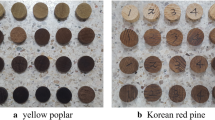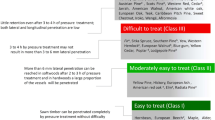Abstract
The reaction between wood components and vaporous formaldehyde was applied to the evaluation of gas permeability and forecast of the extent where the reaction occurs. The structural changes of pre-compression wood, which is a new method to suck the liquid reagent by the recovery force, was also followed by the established method. The formaldehyde content (y) reacted with wood components decreased exponentially as according as the depth from the penetrating surface. It could be expressed by the distance from surface, x, for both longitudinal and tangential directions as follows; y=kexp(−ax) where, a and k are constants for individual wood samples. The half-interval (a definite distance of half reduction), d 1/2, was defined by (ln 2)/a. The reaction level at the arbitral inner portion of wood can be estimated by both the half-interval and the reaction level at the vicinity of surface region. The use of the structural changes of pre-compression wood is suggested.
Zusammenfassung
Die Reaktion zwischen Holzkomponenten und gasförmigem Formaldehyd wurde benutzt, um die Eindringtiefe eines Gases abzuschätzen und das Ausmaß der Reaktion vorherzusagen. Strukturelle Veränderungen von vorverdichtetem Holz, die genutzt werden, um Flüssigkeit und Relaxationskräfte einzusaugen, wurden ebenfalls verfolgt. Der Anteil an Formaldehyd (y), der mit Holz reagiert, fiel exponentiell mit der Eindringtiefe ab. Er konnte sowohl in Längsrichtung als auch tangential als Funktion der Entfernung von der Oberfläche (x) ausgedrückt werden y=kexp(−ax), wobei a und k Konstanten für die jeweiligen Holzproben darstellen. Ein „Halbwert-Intervall“, d. h. die Entfernung d 1/2, bei der die Gasmenge auf die Hälfte reduziert ist, ist gegeben durch ((ln 2)/a. Das Ausmaß der Reaktion an irgendeiner Stelle kann sowohl über das „Halbwert-Intervall“ als auch in der Nähe der Oberfläche abgeschätzt werden. Die Methode der Tränkung mittels Strukturveränderungen wird bei vorverdichtetem Holz empfohlen.








Similar content being viewed by others
References
Andoh M, Takahashi N, Yoshizawa N (1996) Rupture of pit membranes and quality improvement in sugi logs by a smoke-heating system with increased radiation of far infrared rays. Mokuzai Gakkaishi 42:845–853
Booker RE, Evans JM (1994) The effect of drying on the radial permeability of Pinus radiata D. Don. Holz Roh- Werkstoff 52:150–156
Bramhall G (1971) The validity of Darcy’s law in the axial penetration of wood. Wood Sci Technol 5:121–134
Hattori N (1995) Laser processing of wood. Mokuzai Gakkaishi 41:703–709
Iida I, Takayama C, Miyagawa O, Imamura Y (1992) Liquid penetration of precompressed wood. Part 1 Effect of compressive deformation and recovery upon liquid uptake. Mokuzai Gakkaishi 38:233–240
Jones TG, Walker JCF, Langrish TAG (1995) Dissolved carbon dioxide gas diffusion in green Nothofagus fusca heartwood. Wood Sci Technol 29:171–176
Kanagawa Y (1992) Improvement of permeability and drying property of Japanese cedar by local steam-explosion. In: Proceedings of the 22nd symposium on the chemical processing of wood held at Tokushima, Japan, pp 31–37 [in Japanese]
Minato K, Yasuda R, Yano H (1990) Improvement of dimensional stability and acoustic properties of wood for musical instruments with cyclic oxymethylene. Part 2 Formalization with tetraoxane. Mokuzai Gakkaishi 36:990–996
Perng WR (1980) Studies on flow in wood. Part 1: Permeability and axial structural variation. Mokuzai Gakkaishi 26:132–138
Petty JA, Puritch GS (1970) The effects of drying on the structure and permeability of the wood of Abies grandis. Wood Sci Technol 4:140–154
Petty JA (1976) Influence of mean free path on gas flow in wood. Wood Fiber Sci 8:168–171
Roff WJ (1956) The determination of the formaldehyde yield of cellulose textiles treated with formaldehyde, urea-formaldehyde, or melamine-formaldehyde. J Textile Inst 47:309–318
Wiley AT, Choong ET (1975) Some aspects of non-darcy behavior of gas flow in wood. Wood Fiber Sci 6:298–304
Yano H, Minato K (1992) Improvement of the acoustic and hygroscopic properties of wood by chemical treatment and application to the violin parts. J Acous Soc Am 92:1222–1227
Acknowledgement
The authors wish to thank Dr. I. Iida, Kyoto Prefectural University, for preparing the compression wood.
Author information
Authors and Affiliations
Corresponding author
Rights and permissions
About this article
Cite this article
Minato, K., Naruo, N. & Konishi, J. How far does a gaseous reagent penetrate into wood. Holz Roh Werkst 62, 120–125 (2004). https://doi.org/10.1007/s00107-003-0457-7
Published:
Issue Date:
DOI: https://doi.org/10.1007/s00107-003-0457-7




